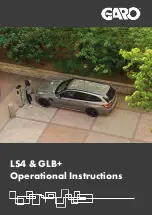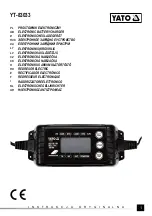
MODEL: . . . . . . . . . . . . . . . . . . .BOOST120 . . . . . . BOOST140 . . . . . . BOOST160 . . . . . . BOOST180
Volts Input:. . . . . . . . . . . . . . . . . . . . . . . 230V . . . . . . . . . . . .230V . . . . . . . . . . . . 230V . . . . . . . . . . . .230V
Watts Input: . . . . . . . . . . . . . . . . . . . . . 800W . . . . . . . . . . . 900W . . . . . . . . . . .1000W . . . . . . . . . . 1200W
Volts output: . . . . . . . . . . . . . . . . . . . 12/24V . . . . . . . . . . 12/24V . . . . . . . . . . .12/24V . . . . . . . . . . 12/24V
rated charging current: . . . . . . . . . . . . . 16A . . . . . . . . . . . . .21A. . . . . . . . . . . . . 26A . . . . . . . . . . . . . 36A
Maximum charging current: . . . . . . . . . . 20A . . . . . . . . . . . . .25A. . . . . . . . . . . . . 30A . . . . . . . . . . . . . 40A
output start Peak (En): . . . . . . . 120A (70A) . . . . . . .140A (80A) . . . . . . 160A (110A) . . . . . . 180A (120A)
charge capacity: . . . . . . . . . . . . . 20-250Ah . . . . . . . . 20-280Ah . . . . . . . . 25-320Ah . . . . . . . . 30-400Ah
Polarity Protection: . . . . . . . . fuse (2 x 50A) . . . . fuse (2 x 50A) . . . . fuse (2 x 50A) . . . fuse (1 x 110A)
fuse: . . . . . . . . . . . . . . . . . . . . . .120/802259 . . . . . . 120/802259 . . . . . . . 120/802259 . . . .stArt360.f10
. . . . . . . . . . . . . . . . . . . . . . . . . . . .
Pack of 20
. . . . . . .
Pack of 20
. . . . . . . .
Pack of 20
. . . . . . .
Pack of 10
read the vehicle handbook to check for any specific battery charging information.
Disconnect the battery from the vehicle and move it to a safe, dry, level area for charging. If the battery can not be removed from the
vehicle refer to manufacturer’s handbook.
check the electrolyte fluid level in the battery is above the plates. If not, add distilled water to cover them by 5-10mm.
DO NOT
touch
the battery fluid as it is corrosive.
clean the charger clamps and battery terminals, removing any oxidation before connecting the charger to the battery.
Ensure that the correct polarity clamp is attached to the correct terminal of the battery. PosItIVE is indicated by (+) and may be red,
nEGAtIVE is indicated by (-) and may be black. If there are no identifiable symbols, you can distinguish the nEGAtIVE battery terminal
as the one which is connected from the battery directly to the vehicle body.
remove the battery electrolyte cover or caps to allow the gases produced by charging to escape.
Keep children and unauthorised persons away from the work area.
DO NOT
attempt to charge a non-rechargeable battery.
DO NOT
use the charger for any purpose other than that for which it is designed.
DO NOT
allow untrained persons to operate the charger.
DO NOT
allow the charger terminal clamps to touch each other when the power is on or the charger fuse will blow. remember that
gases are produced which may ignite if sparks occur.
DO NOT
place the charger inside the vehicle. remove the battery to a safe distance for charging.
DO NOT
get the charger wet or use in damp or wet locations or areas where there is condensation.
DO NOT
operate the charger if it is damaged.
DO NOT
attempt to open or modify the charger.
When not in use, unplug from the mains power supply and store in a safe, dry, child proof area.
WARNING!
Be vigilant and cautious during battery charging as the electrolyte is highly corrosive and the gases emitted are flammable
and harmful to health.
2. INTRODUcTION & SPEcIFIcATIONS
Original Language Version
Boost120, Boost140, Boost160, Boost200 Issue: 1 - 15/05/12
2.1
Combination units capable of both charging batteries and providing boost power to help start vehicles with flat batteries. Models feature
easy-to-read ammeters and illuminated power switches. All models have dual output (12/24V) and circuitry is protected by a panel
mounted fuse. Model No. BOOST120 is suitable for fleet operators running cars. Model No's BOOST140 & BOOST160 are suitable for
fleet operators with both cars and van derivatives. Model No. BOOST180 is suitable for heavier garage use for engines up to 3ltr
capacity.
1.4. PERSONAL PREcAUTIONS
Ensure that there is another person within hearing of your voice and close enough to come to your aid,
should a problem arise when working near a lead-acid battery.
Wear safety eye protection and protective clothing. Avoid touching eyes while working near battery.
Have fresh water and soap nearby in case battery acid contacts skin, clothing, or eyes.
Wash immediately with soap and water if battery acid contacts skin or clothing. If acid enters eye, flush eye immediately with cool,
clean running water for at least 15 minutes and seek immediate medical attention.
remove personal metallic items such as rings, bracelets, necklaces and watches. A lead-acid battery can produce a short-circuit
current high enough to weld a ring to metal, which would cause severe burns.
Ensure that hands, clothing (especially belts) are clear of fan blades and other moving or hot parts of the engine. remove ties and
contain long hair.
DO NOT
smoke or allow a spark or flame in the vicinity of battery or engine.
this appliance is not intended for use by persons (including children) with reduced physical, sensory or mental capabilities or lack of
experience and knowledge, unless they have been given supervision or instruction concerning the use of the appliance by a person responsible
for their safety. children should be supervised to ensure that they do not play with the appliance.
DANGER! BE AWARE, LEAD-ACID BATTERIES GENERATE EXPLOSIVE GASES DURING NORMAL BATTERY OPERATION. FOR THIS
REASON, IT IS VERY IMPORTANT TO READ AND FOLLOW THESE INSTRUCTIONS CAREFULLY, EACH TIME YOU USE THE CHARGER.
Follow these instructions and those published by the battery and vehicle manufacturers and the manufacturer of any equipment
you intend to use in the vicinity of the battery. Remember to review warning marks on all products and on engines.
2.2






















